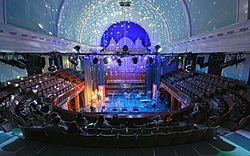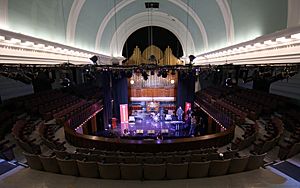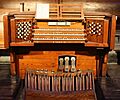Casavant Frères Ltée. Opus 1841 (Highland Arts Centre Organ) facts for kids
Quick facts for kids
Casavant Frères Ltée. Opus 1841
|
|
|---|---|

Casavant Frères Ltée. Opus 1841
|
|
| Background information | |
| Origin | Sydney, Nova Scotia, Canada |
| Genres | classical, folk, popular, worship |
| Years active | 1911–present |
| Labels | Highland Arts Theatre |
The Casavant Frères Ltée. Opus 1841 is a huge musical instrument called a pipe organ. It was built by the famous company Casavant Frères in Saint-Hyacinthe, Quebec, Canada.
This amazing organ was first finished in 1911. Back then, it was known as Casavant Brothers - Opus 452. It was made for the St. Andrew's Presbyterian Church in Sydney, Nova Scotia. That church later became St. Andrew's United Church and is now the Highland Arts Theatre.
Today, the Opus 1841 organ has 33 different sounds, called speaking stops. These sounds are controlled by three manuals (keyboards for hands) and pedals (keyboard for feet). With 2,045 pipes, it is the biggest pipe organ on Cape Breton Island. Its pipes range from tiny (about 19 mm) to very long (about 4.9 meters). The organ's front, its case, pipes, and special sound boxes fill up the back part of the theatre.
Contents
The Organ's Journey: A History

1911: The Beginning
The original organ, Opus 452, was bought for the new church in 1911. It cost $5,395. This first organ was very heavy, weighing over 13 metric tons. It had three manuals, four sections, 29 stops, 27 registers, 29 ranks (groups of pipes), and 1,843 pipes.
1946: A Big Rebuild
In 1946, Casavant Frères Ltée. rebuilt the organ. It was given a new name: Opus 1841. This rebuild cost $7,600. During this work, parts of the organ's key and stop actions were made electric. Three new Choir stops were added. A new, traditional-style console (the part with the keyboards) was also installed.
After the rebuild, the organ had three manuals, four sections, 33 stops, 30 registers, and 32 ranks, with a total of 2,045 pipes. The hand keyboards had 61 notes, and the foot pedals had 32 notes. It was also updated with electro-pneumatic (EP) chests, which help the pipes sound.
1962-1963: Sound Changes
In 1962 and 1963, more work was done on the organ. Some of its stops were sent back to the factory to be reshaped. For example, the Clarion 4' replaced the Vox Humana, and the Trompette 8' replaced the Cornopean. A new Hooded Harmonic Trumpet replaced an older Trumpet on the Great Organ. These changes were made by Casavant through a service company in Halifax.
New lead tubing was added for the pipes you can see on the front of the organ. These pipes aren't just for show; 30 of them actually make sounds! The organ gets its wind (air) from a powerful 3 hp electric blower located in the basement below it.
1985 to 2005: Tubing Upgrades
Over a period of 20 years, almost all the old tubing inside the organ was replaced with new vinyl plastic tubing. For one small section of 32 pipes, about 300 meters of tubing had to be replaced!
2008: Bellows Repair
In 2008, the 18-ton organ had $15,000 worth of repairs done to its bellows. The old sheepskin seams were replaced with a special rubberized bellows cloth. These repairs were done by Maritime Pipe Organ Builders Ltd. from Moncton, New Brunswick. The tubular chimes in the Swell Organ, which were donated around 1929, were disconnected during these repairs.
2017: Fine-Tuning the Reeds
In February 2017, organ tuner Jean-François Mailhot spent a week working on Opus 1841. He cleaned and adjusted the reed stops of the swell organ, including the 8' Trompette, the 8' Oboe, and the 4' Clarion. He also worked on the 16' Trombone of the Pedal Organ. During this time, he fixed a damaged pipe on the front of the organ, which was part of the 8' Open Diapason stop.
Organ Features
- Builder: Casavant Frères Ltée, St. Hyacinthe, Québec, Canada
- Original Build: Casavant Brothers - Opus 452, 1911
- Rebuild: Opus 1841, 1946
- Console: Traditional style with a roll top
- 3 keyboards for hands (manuals)
- Pedals for feet, set up in the standard way for organists
- Controls: Drawknobs (pull-out knobs for sounds)
- Speaking Stops: 33 different sounds
- Total Pipes: 2,045 pipes
- Wind Power: A 3 horsepower electric blower
Organists Through the Years
Many talented organists have played this instrument over the years. Here are some of them:
- W. D. Fife (signed the original contract)
- A. F. MacKinnon
- Fred Liscombe
- Edward Stuart
- H. W. Sparrow
- William Raines
- John B. Neild (played after World War I)
- William E. Fletcher
- R. MacK. Wiles
- A. J. McKnight
- Mrs. Frank Crossen
- W. D. Fife (returned during WWII)
- Clifford L. Gates (started in 1946)
- Vernon H. Atkinson (started in 1951)
- S. Peter Fraser (started in 1964)
Concerts and Performances
When it was still a church, St. Andrew's was known as one of the best places for concerts in Sydney. The building had a long history of hosting performances even before it became an arts center.
The St. Andrew's Choir often performed large musical pieces called cantatas. Sometimes, choirs from eight different churches in Sydney would gather at St. Andrew's to sing Christmas carols together.
Classical musicians often held concerts and recitals there because of the building's amazing sound quality and its Casavant Frères organ. In the mid-1950s, the Halifax Symphony Orchestra regularly performed at St. Andrew's. Their concerts were even broadcast on CBC Radio across the region and nationally. The conductor, Thomas Mayer, would often invite local singers to join them.
More recently, because it can seat over 1,000 people and has excellent acoustics, the theatre has been a popular venue for groups like Celtic Colours, The Barra MacNeils, and the Cape Breton Chorale.
Images for kids
-
Pipes of the Pedal Organ. The foot, cap, block and mouth of several of the large pipes of the Open Diapason 16'. The middle pipe shown sounds FFF♯ (23.125 Hz). These are the organ's largest wooden pipes with nine pipes grouped together on their own wind chest, each pipe with double air valves to accommodate the large amount of air they require to sound.

















